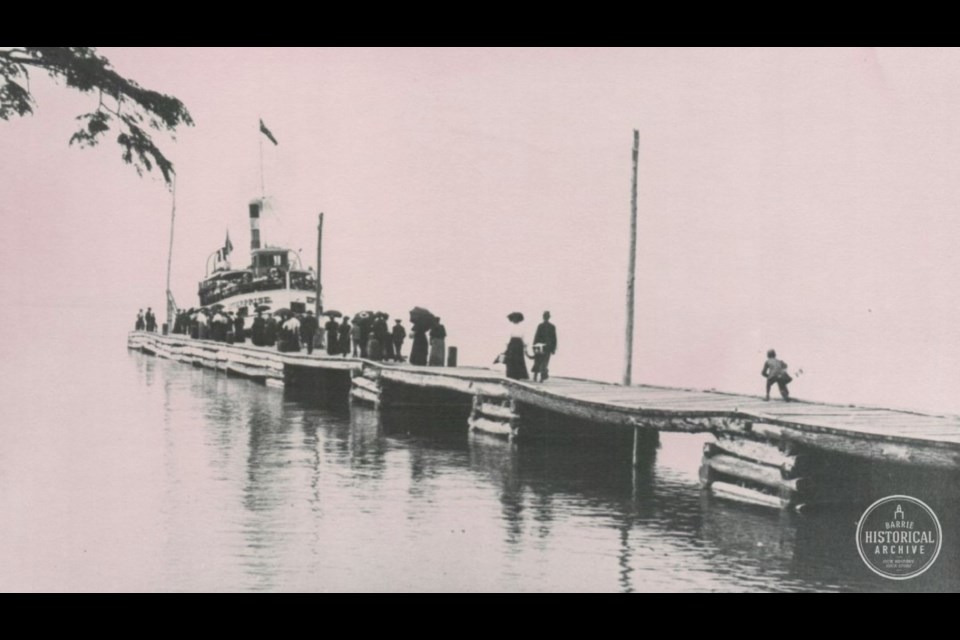Part 1 of this column can be found here.
It was to be the last run of the season. It became the last run ever.
On Nov. 22, 1906, the steamer J.H. Jones left Owen Sound and headed for Lion’s Head with passengers and a cargo of coal oil, brick-making machinery, a sleigh and other goods. They made it as far as Cape Croker.
The lighthouse keeper at Cape Croker was the last person to see the J.H. Jones. He reported she was obviously struggling with the high waves on stormy Georgian Bay. He turned away for just a moment, looked back again, and the J.H. Jones was gone.
It was some six weeks before any hint of the fate of the J.H. Jones was confirmed. On Jan. 6, 1907, the body of a man was found washed up onto the shore of Christian Island. Nearby was a life preserver from the J.H. Jones.
The Northern Advance described the unfortunate man in hopes he might be identified: “According to the description given by the Indians, the victim wore a dark tweed check suit, white collar and shirt, laced boots with rubbers on. He is 5 feet 8 inches tall, about 150 pounds in weight, light colored hair, no moustache. In his pockets were found a gold watch, Egin movement, which had stopped at 7:45, $1.25 in silver and 5c in coppers, three collar buttons, one jack knife, one handkerchief in side pocket and a pocket dictionary.”
The man was identified as 33-year-old Richard Addison, a passenger aboard the J.H. Jones. Addison, a resident of Manitoulin Island, was returning from a trip to Oxford County. He was the only person aboard the ill-fated boat to be found or identified.
Not surprisingly, Addison’s death registration shows he died due to drowning. The cold lake water would also have been merciless. The duration of his affliction was short, the document states, and the name of the attending doctor was given as “the Good Physician.”
The stories of the others aboard are both fascinating and sad, and they speak to the generally perilous conditions of travel by water in those days.
Alexander Lyons, another passenger, was on his way to Lion’s Head. He had recently returned from Yukon and had narrowly avoided death when he was shipwrecked in a Pacific storm.
Lake Huron has been given the unenviable title of shipwreck capital of the world by some. There are said to be more than 1,000 lost vessels at the bottom of the lake, all attached to tragic human stories, no doubt.
There are shipwreck sites to be found in Lake Simcoe as well. None of these sinkings resulted in a large number of fatalities.
Of course, there were close calls.
The Enterprise, an 89-foot steamer, carried many passengers up and down Lake Simcoe from 1868 until 1903. In August 1903, the captain of the Enterprise discovered the vessel had serious mechanical issues just after leaving Big Bay Point with a boat full of passengers.
Nevertheless, he rolled the dice and carried on toward Barrie, fingers crossed that they could make it there.
As the Enterprise approached Barrie, the steamer was taking on water faster than its pumps could divert it. Only one of the two twin-screw propellers was functioning. The crew desperately tried to keep the water away from the fire hole.
Should water reach that point, no more steam could be produced, thus disabling the pumps and stopping the forward movement of the boat.
The government dock was the usual terminus of these voyages, but the crew of the Enterprise did not think they could make it that far. The steamer was brought close to shore and plans were made to beach the Enterprise at Fisherman’s Point, east of Barrie.
Instead, they carried on and just made it to the wharf at the foot of Mulcaster Street, where the relieved crew and passengers disembarked.
Minutes after the last person left the steamer, the water reached the fire hole. Without the pumps, the water rapidly filled the hole and the Enterprise sank.
The Enterprise was later refloated and taken to Jackson’s Point, where it was stripped of any usable parts and then scuttled.
The hull was rediscovered by divers in 1998.
And the J.H. Jones? Using statements made by the Cape Croker lighthouse keeper in 1906, a crew of divers and researchers, along with a great-grandson of Capt. J.V. Crawford, set out to look for the remains of the boat on a summer day in 2018.
It took them one hour and 45 minutes to find her.
Each week, the Barrie Historical Archive provides BarrieToday readers with a glimpse of the city’s past. This unique column features photos and stories from years gone by and is sure to appeal to the historian in each of us.



